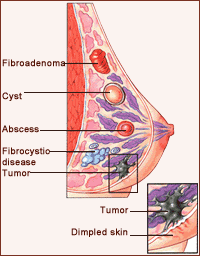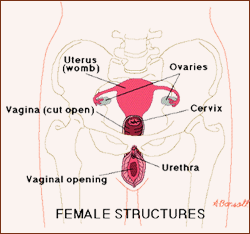Breast Cancer
Breast Cancer, which is the second most common cancer makes up for almost nine per cent of all new cancer cases in India. It occurs when cells of the breast grow and multiply in an uncontrolled manner. Though the exact cause still eludes scientists, the abnormal cell division appears to be the result of some mutation in the cell's DNA. However, a number of risk factors have been identified which could help women stay alert.

Age
The risk of breast cancer increases with age; a
70- year-old woman is more vulnerable than a
40-year-old. Therefore, it is important that all
women above 50 undergo regular breast mammograms.
Family history
Family history is an important risk factor for breast
cancer. In families with a bad gene for breast cancer,
around half of the female members develop the cancer,
usually before 40 years of age. Often, both breasts are
affected. On the other hand, if one or two women out of 20
family members develop breast cancer and both are above 60,
then this probably does not increase the risk of breast
cancer.
Reproductive factors
A woman who has had her first child before the age of 23 has one-third the risk of breast cancer compared with a woman who has her first baby at 30. Breast-feeding for at least three months has a protective effect.
The sooner cancer is diagnosed and treated, the better the patient's chances for a full recovery. For early detection it is necessary that the person has regular medical check-ups and does self-examinations. Women should talk to their doctors about this disease, the symptoms to watch for and check-ups.
How often should a Women have Check-ups?
- From age 35 self-examine your breasts once every month.
- From 40, continue self-examinations and have your doctor examine your breasts once a year.
- From age 50, get a mammogram done every two years. In addition, continue self-examination and check-ups by the doctor.
Some warning signals that are associated with early stage breast cancer are:
- Dimpling of the skin or changes to breast texture or shape.
- Changes in nipple shape or unexplained discharge.
- Breast lumps or skin thickening.
- Underarm tenderness or skin changes.
Diagnosis
Mammogram is an X-ray of the breasts that can detect tumours in the breast much before they are big enough to be felt by hand. The test is a must once a year for all women over 50. But women who fall into high-risk categories-those with a family history of breast cancer and those who have already had breast cancer once - should begin screening by 35, at the latest. However, a mammogram may not find every abnormal area in the breast. This is especially true in the breasts of young women.
Breast exams by a qualified medical professional also help in detecting lumps. Between visits to the doctor, women should examine their breasts once every month. Self-examinations help them learn what looks and feels normal for their breasts. Changes should be reported to the doctor immediately. Every lump in the breast may not be cancerous but only the doctor can make a correct diagnosis.
Treatment
A woman diagnosed with breast cancer has several options before her. A small tumour is usually treated with lumpectomy (removal of the tumourous lump). After removing the lump, the axillary lymph nodes are removed. The breast is then subjected to radiotherapy and chemotherapy. If required, hormonal treatment is also given. To make the two breasts equal in size, a reduction surgery is done on the larger one. Bigger tumours may require removing the entire breast. This is called mastectomy.
Mastectomy is usually followed by reconstruction surgery (on request by the patients) as it spares the women the shock of seeing themselves without breasts.
Reconstruction Surgery
Cancer of the Cervix, Uterus & Ovary
Cancers can hit the uterus and the ovaries. Uterine cancer is of two types: cervical and endometrial.
Cervical cancer
Occurs in the cervix, the canal between the vagina and the uterus. This is the most common cancer among Indian women.

You are more likely to be affected if you:
- Have had sexual encounters at an early age
- Have multiple sexual partners
- Have poor genital hygiene
Watch out for:
- Blood in vaginal discharge
- Unusual bleeding between periods
- Unusual bleeding after intercourse
Help at hand
The cervix can be removed through surgery, if the cancer has not spread to other parts of the body. Radiotherapy is useful in the second and third stages.
Precautions
The Pap test detects signs of cervical cancer early on. Have a Pap test every year if you are:
Endometrial Cancer
Occurs within the uterus. Usually occurs among older women and is influenced by genetic predisposition to the disease.
You are more likely to be affected if you:
- Are over 40
- Are overweight
- Take hormones
- Are infertile
- Do not ovulate
Watch out for:
- Blood in vaginal discharge
- Abnormal bleeding - bleeding other than menstrual flow
Help at hand
If only the uterus has been affected, a hysterectomy (surgical removal of the uterus) helps. If the cancer has spread, the surgery must be followed up with radiotherapy. Chemotherapy is used in advanced conditions.
Ovarian cancer
Occurs in the ovaries, which produces the ova or eggs. This type of cancer is common among older women.
Watch out for:
- Discomfort in the lower abdomen
- Swelling of the abdomen
- Loss of weight
- Back ache
- Occasional breathlessness
Help at hand
The vast majority of women diagnosed with first and second stage ovarian cancer survive with proper treatment. If the cancer is caught in the first stage, cure is possible through surgery. This is supplemented with radiation for second-stage cancers. Chemotherapy is used only in the final stages.

